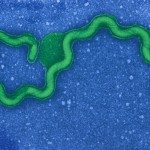Link to Pubmed [PMID] – 21471336
J. Clin. Microbiol. 2011 Jun;49(6):2154-60
Leptospirosis is considered an underdiagnosed disease. Although several PCR-based methods are currently in use, there is little information on their comparability. In this study, four quantitative real-time PCR (qPCR) assays (SYBR green and TaqMan chemistries) targeting the secY, lfb1, and lipL32 genes were evaluated as diagnostic assays. In our hands, these assays can detect between 10(2) and 10(3) bacteria/ml of pure culture, whole-blood, plasma, and serum samples. In three independent experiments, we found a slightly higher sensitivity of the PCR assays in plasma than in whole blood and serum. We also evaluated the specificity of the PCR assays on reference Leptospira strains, including newly described Leptospira species, and clinical isolates. No amplification was detected for DNA obtained from saprophytic or intermediate Leptospira species. However, among the pathogens, we identified sequence polymorphisms in target genes that result in primer and probe mismatches and affect qPCR assay performance. In conclusion, most of these assays are sensitive and specific tools for routine diagnosis of leptospirosis. However, it is important to continually evaluate and, if necessary, modify the primers and/or probes used to ensure effective detection of the circulating Leptospira isolates.

